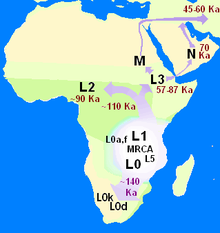
Back Mitochondriale Eva Afrikaans حواء الميتوكوندرية Arabic Мітахандрыяльная Ева Byelorussian Митохондриална Ева Bulgarian মাইটোকন্ড্রিয়াল ইভ Bengali/Bangla Mitohondrijska Eva BS Eva mitocondrial Catalan حەوای میتۆکۆندریایی CKB Mitochondriální Eva Czech Mitokondrielle Eva Danish
| Haplogroup L | |
|---|---|
 | |
| Possible time of origin | c. 100–230 kya[note 1][note 2] |
| Possible place of origin | East Africa |
| Ancestor | n/a |
| Descendants | |
| Defining mutations | None |
In human genetics, the Mitochondrial Eve (more technically known as the Mitochondrial-Most Recent Common Ancestor, shortened to mt-Eve or mt-MRCA) is the matrilineal most recent common ancestor (MRCA) of all living humans. In other words, she is defined as the most recent woman from whom all living humans descend in an unbroken line purely through their mothers and through the mothers of those mothers, back until all lines converge on one woman.
In terms of mitochondrial haplogroups, the mt-MRCA is situated at the divergence of macro-haplogroup L into L0 and L1–6. As of 2013, estimates on the age of this split ranged at around 155,000 years ago,[note 3] consistent with a date later than the speciation of Homo sapiens but earlier than the recent out-of-Africa dispersal.[4][1][5]
The male analog to the "Mitochondrial Eve" is the "Y-chromosomal Adam" (or Y-MRCA), the individual from whom all living humans are patrilineally descended. As the identity of both matrilineal and patrilineal MRCAs is dependent on genealogical history (pedigree collapse), they need not have lived at the same time. As of 2015, estimates of the age of the Y-MRCA range around 200,000 to 300,000 years ago, roughly consistent with the emergence of anatomically modern humans.[6]
The name "Mitochondrial Eve" alludes to the biblical Eve, which has led to repeated misrepresentations or misconceptions in journalistic accounts on the topic. Popular science presentations of the topic usually point out such possible misconceptions by emphasizing the fact that the position of mt-MRCA is neither fixed in time (as the position of mt-MRCA moves forward in time as mitochondrial DNA (mtDNA) lineages become extinct), nor does it refer to a "first woman", nor the only living female of her time, nor the first member of a "new species".[note 4]
- ^ a b c Cite error: The named reference
Soares09was invoked but never defined (see the help page). - ^ a b Poznik GD, Henn BM, Yee MC, Sliwerska E, Euskirchen GM, Lin AA, et al. (August 2013). "Sequencing Y chromosomes resolves discrepancy in time to common ancestor of males versus females". Science. 341 (6145): 562–565. Bibcode:2013Sci...341..562P. doi:10.1126/science.1237619. PMC 4032117. PMID 23908239.
- ^ Cite error: The named reference
Fu2013was invoked but never defined (see the help page). - ^ Endicott P, Ho SY, Metspalu M, Stringer C (September 2009). "Evaluating the mitochondrial timescale of human evolution". Trends in Ecology & Evolution. 24 (9): 515–521. doi:10.1016/j.tree.2009.04.006. PMID 19682765.
- ^ "New 'molecular clock' aids dating of human migration history". University of Leeds. 3 June 2009. Retrieved 23 December 2019.
- ^ Karmin; et al. (2015). "A recent bottleneck of Y chromosome diversity coincides with a global change in culture". Genome Research. 25 (4): 459–66. doi:10.1101/gr.186684.114. PMC 4381518. PMID 25770088. "we date the Y-chromosomal most recent common ancestor (MRCA) in Africa at 254 (95% CI 192–307) kya and detect a cluster of major non-African founder haplogroups in a narrow time interval at 47–52 kya, consistent with a rapid initial colonization model of Eurasia and Oceania after the out-of-Africa bottleneck. In contrast to demographic reconstructions based on mtDNA, we infer a second strong bottleneck in Y-chromosome lineages dating to the last 10 ky. We hypothesize that this bottleneck is caused by cultural changes affecting variance of reproductive success among males."
- ^ "Jordan: 'Mitochondrial Eve'". weber.ucsd.edu. 2011. Retrieved 7 January 2012.
Cite error: There are <ref group=note> tags on this page, but the references will not show without a {{reflist|group=note}} template (see the help page).